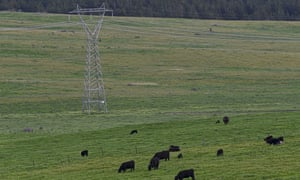Extract from The Guardian
Australian Energy Market Commission says households could expect to pay $120 less
Electricity for consumers will be cheaper in 2023 as new generation capacity enters the power grid, including 1,667 megawatts of solar and 2,580 megawatts of wind, the Australian Energy Market Commission said.
The AEMC’s annual price assessment projected that power prices would decrease until 2021-22 and then potentially increase during 2022-23. But prices in 2023 were expected to be lower than they are now.
Households are expected to pay $120 less in 2023. The price reductions are primarily driven by a decline in wholesale electricity costs across most Australian states and territories, and lower gas prices.
The potential price increase in 2022-23 relates to the ageing Liddell power station in New South Wales closing.
The AEMC said supply could tighten during this period although it noted the ultimate outcome “will likely be affected by the recent announcement from the NSW government about the electricity infrastructure roadmap”.
The Berejiklian government’s electricity infrastructure roadmap will support 12 gigawatts of renewable energy and 2 gigawatts of energy storage, with a focus on pumped hydro, over the next decade. The state’s energy minister, Matt Kean, said this plan was about ensuring the coal transition was orderly so new generation was in place before current assets left the system.
The AEMC’s snapshot was undertaken before the NSW announcement. The Victorian government is also supporting 928 megawatts and promised at least another 600 megawatts through its renewable energy target as it aimed to reach 50% renewable energy power by 2030.
The commission’s chief executive, Ben Barr, said: “The outcome for 2023 prices may well be different following recent announcements on increasing renewable energy capacity in both NSW and Victoria.
“We conducted our analysis before those announcements were made and so our numbers do not reflect the impact those developments could have on prices – and in any case, the overall figures show that prices in 2023 will still be lower than they are today.”
On the AEMC’s forecasts nationally, wholesale costs are expected to fall by about $150 between the financial years 2019-20 and 2022-23 – which also reflects the new generation capacity entering the system and lower gas prices.
The AEMC expected network, distribution and metering costs to fall and transmission costs to increase. Environmental costs in the system would be lower as more renewable generation came online.
The price impacts varied across the states and territories.
In south-east Queensland, prices were expected to fall by 14%, in Victoria 15%, NSW 2% and Tasmania 4%. Canberra will buck the trend. It is forecast to rise by 2%.
In the ACT, wholesale costs are expected to decline by 13.4% but regulated network costs are expected to increase by 14.6% “driven by an increase in distribution and transmission costs and partly due to previous under-recoveries and higher operating expenditure”.
The AEMC’s forecast does not include the Northern Territory or Western Australia. The commission said its numbers were projections not predictions, and said trends can change sharply in response to new policies and sudden market changes.
The Australian Energy Council – which represents Australia’s energy retailers – welcomed the projection and said prices were forecast to decline even during a change in the generation mix in NSW.
Sarah McNamara, the chief executive of the AEC, said: “Despite concerns the closure of the Liddell power station could push up wholesale prices dramatically, the independent assessment shows east coast prices overall will be lower than they are now even after that plant’s departure.”
The government had estimated 1,000 megawatts of new dispatchable electricity generation capacity would be needed to replace Liddell, which owner AGL has said will close in early 2023.
But a taskforce report commissioned to assess the impact of the closure did not find that 1,000MW of additional dispatchable electricity would be needed. It listed a range of energy committed and probable projects that it found would be “more than sufficient” to maintain a high level of power grid reliability as Liddell shut.
The federal energy minister, Angus Taylor, however, noted the potential price impact attributed to the Liddell departure.
“Even though prices are forecast to fall over the next three years, the AEMC predicts a slight increase in prices and bills in 2022-23, which it attributes to the closure of the Liddell power station,” he said.

No comments:
Post a Comment